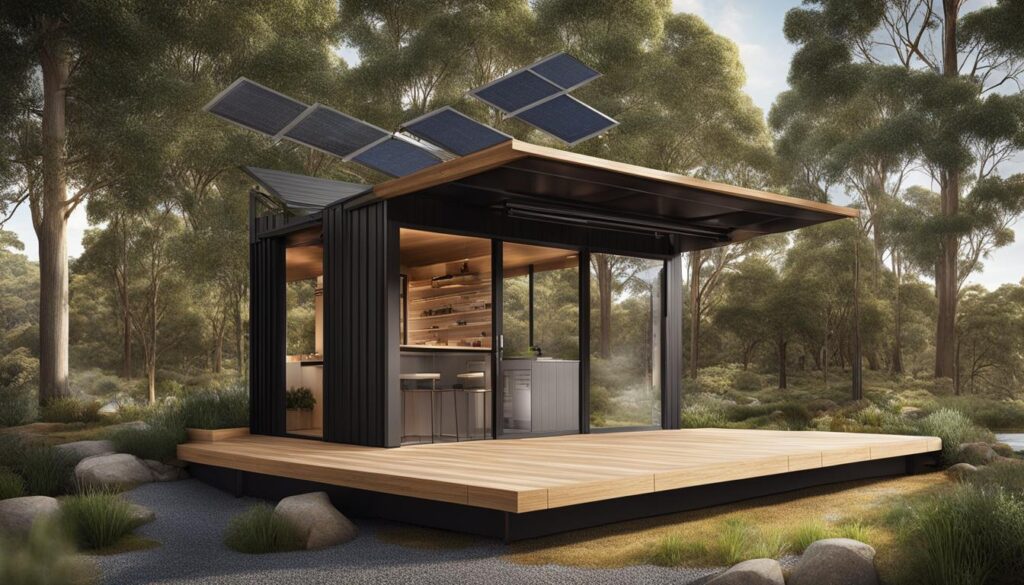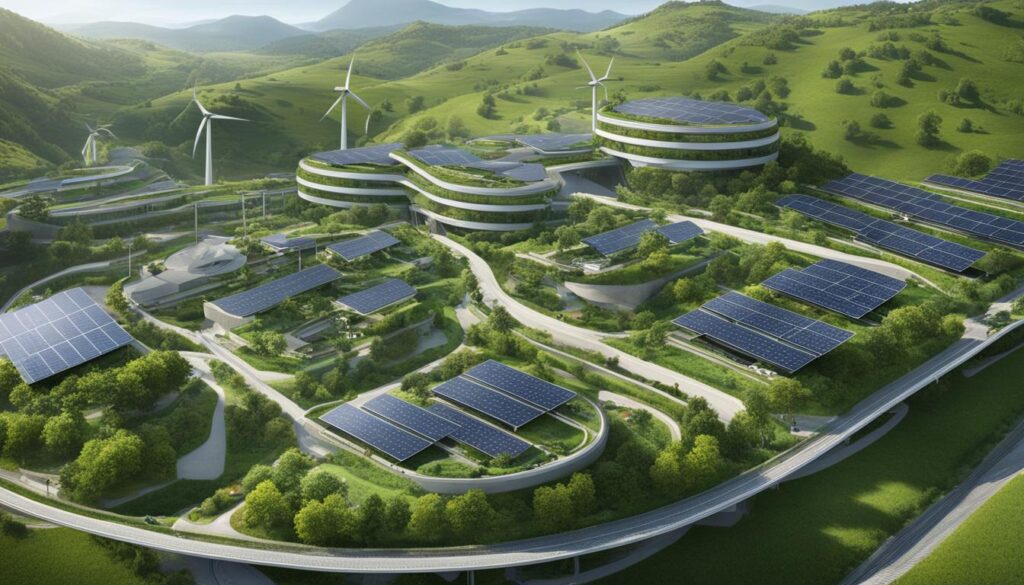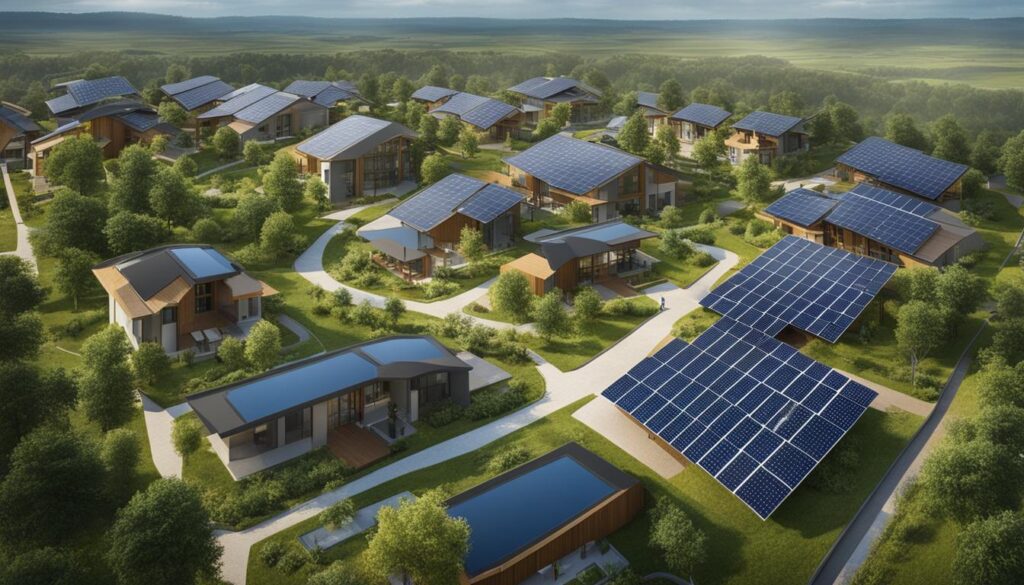G’day folks! Welcome to my guide on Environmentally Sustainable Design (ESD) in the Macedon Ranges Shire Council. In today’s world, sustainable design is the name of the game when it comes to building a better future for our community. It’s all about protecting our environment, saving energy and water, and creating healthier living spaces. So, let’s dive right in and explore how the council is leading the way in ESD!
Key Takeaways
- ESD is vital for protecting the environment and securing our future.
- Macedon Ranges Shire Council focuses on sustainable building categories.
- Resources like Sustainability Victoria and Renew support ESD initiatives.
- Urban consolidation and creek restoration contribute to ESD goals.
- Solar PV installations and climate-responsive town expansion are key opportunities.
Importance of Environmentally Sustainable Design
In today’s rapidly changing world, the importance of environmentally sustainable design (ESD) cannot be overstated. As our planet faces numerous environmental challenges, it is crucial that we adopt sustainable architecture and green building practices to minimize our impact on the Earth. ESD encompasses a wide range of eco-friendly design principles, from energy-efficient construction to the use of renewable materials, all aimed at creating a more sustainable future.
One of the key benefits of implementing ESD is the reduction of environmental impacts associated with buildings. By integrating sustainable practices and materials into the design and construction processes, we can significantly minimize resource consumption and waste generation. This not only helps combat climate change but also promotes the conservation of natural resources.
“Sustainable design is not just about being environmentally friendly; it also makes good economic sense. By creating energy-efficient buildings, we can lower our energy consumption and save on costs in the long run.”
Furthermore, ESD promotes energy efficiency, which is essential for reducing greenhouse gas emissions and combating climate change. By incorporating energy-efficient systems, such as solar panels and smart heating and cooling technologies, we can significantly decrease our reliance on fossil fuels and create buildings that are environmentally responsible and cost-effective.
Incorporating renewable materials
Another important aspect of ESD is the use of renewable materials. Traditional building materials, such as concrete and steel, have a considerable environmental impact due to their high carbon emissions and depletion of natural resources. By utilizing renewable materials, such as bamboo, recycled wood, and green composites, we can minimize our ecological footprint and contribute to a more sustainable construction industry.
| Sustainable Building Practices | Benefits |
|---|---|
| Energy-efficient construction | Reduced energy consumption and cost savings |
| Use of renewable materials | Minimized resource depletion and carbon emissions |
| Eco-friendly design principles | Enhanced indoor air quality and occupant health |
By embracing environmentally sustainable design practices, we have the power to create a built environment that not only meets our present needs but also supports the well-being of future generations. Through sustainable architecture, green building practices, and eco-friendly design, we can ensure a harmonious balance between human development and the preservation of our natural environment.
Benefits of ESD in the Macedon Ranges Shire Council
Implementing Environmentally Sustainable Design (ESD) in the Macedon Ranges Shire Council brings numerous benefits to the community and the environment. By adopting sustainable practices, the council can minimize its ecological footprint and create a more resilient and resource-efficient region.
Promoting Water Conservation
ESD in the Macedon Ranges Shire Council includes efficient water conservation strategies. One example is rainwater harvesting, which collects and stores rainwater for various non-potable uses such as garden irrigation and toilet flushing. Implementing greywater recycling systems also reduces the strain on the municipal water supply and promotes sustainable water management.
Effective Waste Management
Another aspect of ESD in the council is effective waste management. Recycling programs encourage residents and businesses to separate recyclable materials from general waste, reducing the amount of waste sent to landfill. Composting initiatives further minimize environmental impact by diverting organic waste from landfill and enriching the soil.
| Benefits of ESD in the Macedon Ranges Shire Council | Examples |
|---|---|
| Promotes water conservation | Rainwater harvesting, greywater recycling |
| Facilitates effective waste management | Recycling programs, composting initiatives |
By prioritizing water conservation and waste management, the Macedon Ranges Shire Council not only contributes to environmental sustainability but also sets an example for the community. These initiatives not only reduce the strain on natural resources but also promote a more mindful and responsible approach to resource consumption.

As the council continues to embrace ESD, it will create a more livable and environmentally conscious community, ensuring a sustainable future for the Macedon Ranges Shire.
Key Sustainable Building Categories in Macedon Ranges Shire Council
When it comes to sustainable building in the Macedon Ranges Shire Council, there are several key categories that developers and homeowners should focus on. By incorporating these categories into their designs, they can create environmentally friendly and sustainable buildings that contribute to the overall goal of ESD. Let’s take a closer look at each of these categories and their importance in promoting sustainability.
Energy Efficiency
One of the primary goals of sustainable building is to reduce energy consumption and minimize the carbon footprint. By prioritizing energy efficiency, developers can utilize various strategies to ensure that buildings operate in a way that conserves energy. This can include using energy-efficient appliances, implementing smart home technologies, and optimizing insulation and building materials to minimize heat transfer. These measures not only reduce energy consumption but also contribute to cost savings for occupants.
Water Conservation
Water scarcity is a pressing issue globally, and it is crucial for buildings to implement water conservation measures. This can include the use of rainwater harvesting systems, efficient irrigation methods, and low-flow fixtures to reduce water consumption. By prioritizing water conservation, buildings can minimize their impact on local water resources and contribute to the overall sustainability of the region.
Indoor Environmental Quality
Creating a healthy and comfortable indoor environment is essential for sustainable buildings. This category focuses on factors such as proper ventilation, natural lighting, and the use of non-toxic building materials. By incorporating these elements, buildings can promote occupant well-being, reduce the use of artificial lighting and HVAC systems, and improve indoor air quality.
Materials Selection
Choosing sustainable and environmentally friendly materials is another important aspect of sustainable building. This involves considering factors such as the sourcing of materials, their embodied energy, and their potential for recycling or repurposing. By selecting materials with a low environmental impact, developers can create buildings that are both aesthetically pleasing and sustainable.
Overall, the Macedon Ranges Shire Council emphasizes these sustainable building categories to guide developers and homeowners in creating environmentally friendly and sustainable buildings. By incorporating energy efficiency, water conservation, indoor environmental quality, and materials selection into their designs, stakeholders can contribute to a more sustainable future for the region.
Resources for Environmentally Sustainable Design in Macedon Ranges Shire Council
When it comes to implementing environmentally sustainable design (ESD) initiatives, the Macedon Ranges Shire Council provides a wealth of resources and support. These resources empower residents, developers, and homeowners to create a more environmentally friendly and sustainable community. Let’s explore some of the key resources available in the Macedon Ranges region:
Sustainability Victoria
Sustainability Victoria is a valuable resource that offers information, guidance, and support for sustainable living. They provide information on rebates for energy-efficient appliances, renewable energy systems, and water-saving measures. With Sustainability Victoria’s assistance, individuals can make informed decisions and take steps towards creating a more sustainable home and lifestyle.
Renew
Renew is a not-for-profit organization that provides resources and support for sustainable living. They offer a range of publications, including the Renew magazine, which covers topics such as energy efficiency, sustainable building materials, and renewable energy systems. With access to Renew’s resources, individuals can stay up-to-date with the latest trends and technologies in sustainable living.
Your Home
Your Home is an online resource that offers design guides for energy-efficient and sustainable homes. Developed by the Australian Government, Your Home provides valuable information on passive design, energy efficiency, water conservation, and materials selection. By following the design principles outlined in Your Home, individuals can create comfortable and sustainable living spaces.
Tankulator and Sunulator
Tankulator and Sunulator are online tools that assist with sustainable design and planning. Tankulator helps individuals calculate the size of rainwater tanks required for their specific needs, promoting effective water conservation strategies. Sunulator helps with planning for solar power systems, allowing individuals to assess the potential benefits and costs of installing solar panels.
Victorian Green Renters Guide
The Victorian Green Renters Guide is a comprehensive resource designed to help renters adopt sustainable living practices. It provides tips and information on energy efficiency, water conservation, waste management, and sustainable transport options. By following the recommendations in the Victorian Green Renters Guide, renters can make a positive impact on the environment and reduce their ecological footprint.

| Resource | Description |
|---|---|
| Sustainability Victoria | Offers information on rebates, energy efficiency, and water-saving measures |
| Renew | Provides resources for sustainable living, including the Renew magazine |
| Your Home | Offers design guides for passive design and building |
| Tankulator | Helps calculate the size of rainwater tanks |
| Sunulator | Assists in planning for solar power |
| Victorian Green Renters Guide | Offers sustainable living tips for renters |
Urban Consolidation and ESD in Macedon Ranges Shire Council
Urban consolidation presents a unique opportunity to promote Environmentally Sustainable Design (ESD) in the Macedon Ranges Shire Council. By densifying existing areas within proximity to services, we can reduce the pressure on the town boundary and surrounding agricultural land. This approach not only helps preserve natural resources but also promotes economic activity along main streets. It’s a win-win situation for both the environment and the community.
One of the key benefits of urban consolidation is the efficient use of infrastructure. By concentrating development in existing urban areas, we can maximize the use of existing services such as public transport, water, and energy networks. This reduces the need for costly infrastructure expansion and minimizes the environmental impact associated with new developments on greenfield sites.
Furthermore, urban consolidation supports walkability and active transportation. By creating compact, mixed-use neighborhoods, we can encourage people to walk, cycle, or use public transport instead of relying on cars. This not only reduces traffic congestion but also lowers greenhouse gas emissions and improves public health. It’s a step towards creating vibrant and livable communities.
Table: Comparison of Urban Consolidation and Sprawl
| Urban Consolidation | Sprawl | |
|---|---|---|
| Environmental Impact | Reduces environmental footprint by minimizing land consumption and conserving natural resources | Increases environmental footprint by consuming large amounts of land and fragmenting ecosystems |
| Infrastructure Efficiency | Optimizes the use of existing infrastructure and reduces the need for costly expansions | Requires new infrastructure and services, leading to higher costs and resource consumption |
| Transportation | Promotes walkability, cycling, and use of public transport, reducing car dependency and traffic congestion | Relies heavily on private vehicles, leading to increased traffic congestion and air pollution |
| Social Connectivity | Fosters community interaction and social cohesion through compact, mixed-use neighborhoods | Creates dispersed communities with limited social interaction and sense of belonging |
As we strive for a sustainable future, urban consolidation can play a crucial role in achieving our ESD goals. It allows us to create more efficient, connected, and livable communities while minimizing our impact on the environment. By embracing this approach, the Macedon Ranges Shire Council can pave the way for a greener and more resilient future.
Five Mile Creek Restoration and ESD in Macedon Ranges Shire Council
When it comes to promoting environmentally sustainable design (ESD) in the Macedon Ranges Shire Council, the restoration of Five Mile Creek presents a significant opportunity. With a carefully crafted master plan and a comprehensive water-sensitive urban design (WSUD) study, this restoration project aims to enhance the ecological value of the creek, improve habitat connectivity, and promote sustainable land use practices.
The master plan emphasizes the importance of incorporating ecological restoration and pedestrian infrastructure. By restoring the creek’s natural features, we can preserve and enhance the biodiversity of the area while creating a beautiful and functional space for the community to enjoy. Additionally, the WSUD study focuses on managing stormwater runoff, improving water quality, and utilizing water-efficient landscaping techniques, further enhancing the sustainability of the project.
This ambitious restoration project aligns with the council’s commitment to environmental stewardship and showcases the power of ESD in creating resilient and environmentally conscious communities. By investing in projects like the Five Mile Creek restoration, the Macedon Ranges Shire Council is taking proactive steps towards building a sustainable future for the region.
Quote:
“The restoration of Five Mile Creek is not just an ecological endeavor, but a demonstration of our commitment to preserving our natural heritage and fostering a sustainable community for generations to come.” – Mayor of Macedon Ranges Shire Council
| Benefits of Five Mile Creek Restoration | Key Features of the Restoration Project |
|---|---|
|
|

With the restoration of Five Mile Creek, the Macedon Ranges Shire Council is showcasing its commitment to environmental sustainability and creating a greener, healthier, and more vibrant community. By embracing environmentally sustainable design principles, we can preserve and enhance our natural resources while providing valuable recreational and ecological benefits for all residents.
Solar PV for Wastewater Treatment Plant in Macedon Ranges Shire Council
When it comes to embracing environmentally sustainable practices, the Macedon Ranges Shire Council is taking a proactive approach in implementing solar photovoltaic (PV) systems at its wastewater treatment plant. By harnessing the power of the sun, this initiative aims to reduce the reliance on conventional energy sources, lower greenhouse gas emissions, and contribute to the council’s commitment to renewable energy.
The integration of solar PV systems in the wastewater treatment plant not only helps to reduce the carbon footprint but also provides a reliable and cost-effective energy solution. The abundance of sunlight in the Macedon Ranges region makes it an ideal location for generating clean and renewable electricity. By utilizing solar energy, the council can significantly reduce its operational costs while promoting a more sustainable and environmentally friendly approach to wastewater treatment.
The installation of solar PV systems at the wastewater treatment plant aligns with the council’s commitment to sustainability and demonstrates its dedication to exploring innovative solutions for environmental conservation. This initiative not only showcases the council’s forward-thinking approach but also serves as an inspiration for other municipalities and organizations to adopt renewable energy technologies to reduce their environmental impact.
The Benefits of Solar PV for Wastewater Treatment Plant
The integration of solar PV systems in the wastewater treatment plant offers numerous benefits, both environmental and economic. Here are some key advantages:
- Reduced greenhouse gas emissions: Solar PV systems generate electricity without producing harmful greenhouse gas emissions, contributing to the council’s efforts to combat climate change.
- Energy cost savings: By generating its own electricity, the council can reduce its reliance on the grid and significantly decrease energy costs, freeing up funds for other sustainable initiatives.
- Energy independence: The use of solar energy reduces the council’s dependence on conventional energy sources, providing a more reliable and sustainable energy supply for the wastewater treatment plant.
- Community engagement: The installation of solar PV systems demonstrates the council’s commitment to sustainable practices and inspires the local community to embrace renewable energy technologies.
By embracing solar PV technology for its wastewater treatment plant, the Macedon Ranges Shire Council sets a shining example of how sustainability and innovation can go hand in hand. This forward-thinking initiative not only benefits the environment but also enhances the council’s reputation as a leader in environmentally responsible practices.
| Advantages of Solar PV for Wastewater Treatment Plant | Benefits |
|---|---|
| Reduced greenhouse gas emissions | Contributes to combating climate change |
| Energy cost savings | Reduces reliance on the grid and decreases energy costs |
| Energy independence | Reduces dependence on conventional energy sources |
| Community engagement | Inspires local community to embrace renewable energy |
Climate Responsive Town Expansion in Macedon Ranges Shire Council
Expanding our town while mitigating the effects of climate change is a priority for the Macedon Ranges Shire Council. We are committed to incorporating sustainable design elements that adapt to changing climate conditions. With climate-responsive town expansion, we can ensure a greener, more resilient future for our community.
In our efforts to combat rising temperatures and extreme weather events, green infrastructure plays a key role. By integrating more trees, green roofs, and permeable surfaces into our urban areas, we can create natural coolants and reduce the urban heat island effect. This not only improves the comfort of our public spaces but also enhances air quality and promotes biodiversity.
Passive cooling techniques are another vital aspect of climate-responsive town expansion. By designing buildings with appropriate orientation, shading devices, and natural ventilation systems, we can minimize the need for energy-intensive cooling mechanisms. This not only reduces our carbon footprint but also lowers energy costs for residents and businesses.
Lastly, resilient building materials are essential in ensuring our town can withstand the impacts of climate change. By utilizing materials that are durable, fire-resistant, and adaptable, we can future-proof our infrastructure against extreme weather events. This proactive approach reduces the risk of damage and the need for costly repairs or reconstruction in the face of climate-related challenges.

Incorporate sustainable design elements
By incorporating sustainable design elements into our town expansion plans, we can create a greener, more resilient future. This includes integrating green infrastructure, implementing passive cooling techniques, and utilizing resilient building materials.
Benefits of climate-responsive town expansion
Climate-responsive town expansion brings numerous benefits to our community. It improves the comfort of public spaces, enhances air quality, promotes biodiversity, and reduces energy costs. Additionally, it ensures our infrastructure can withstand the impacts of climate change, reducing the risk of damage and the need for costly repairs.
Inter-town Bike Path & Public Transport Upgrade in Macedon Ranges Shire Council
When it comes to sustainable transportation, the Macedon Ranges Shire Council is taking a proactive approach by investing in an inter-town bike path and public transport upgrade. These initiatives not only promote eco-friendly modes of travel but also contribute to reducing traffic congestion and greenhouse gas emissions. As an environmentally conscious community, we understand the importance of providing accessible and sustainable transportation options for our residents.
The inter-town bike path will serve as a dedicated route connecting the various townships within the Macedon Ranges region. This bike path will not only encourage active transportation but also provide an opportunity for residents and visitors to explore the picturesque landscapes of our beautiful shire. Whether it’s a leisurely ride through the countryside or a convenient way to commute between towns, the inter-town bike path will offer a safe and enjoyable cycling experience.
In addition to the bike path, the council is also committed to upgrading the public transport system in the region. This includes improving bus routes, increasing frequency, and enhancing accessibility for all members of the community. By prioritizing public transportation, we aim to reduce reliance on cars and promote sustainable mobility options. A well-connected and efficient public transport network will not only benefit the environment but also improve the overall quality of life for residents in the Macedon Ranges Shire.
| Benefits of the Inter-town Bike Path and Public Transport Upgrade |
|---|
|
“Investing in sustainable transportation infrastructure is a win-win situation for both the environment and the community. By prioritizing the development of an inter-town bike path and upgrading public transport, the Macedon Ranges Shire Council is taking a significant step towards creating a more sustainable and livable region.”
Together, the inter-town bike path and public transport upgrade initiatives will contribute to a greener and more connected Macedon Ranges Shire. These investments in sustainable transportation will not only reduce our carbon footprint but also enhance the overall livability of our community. By embracing eco-friendly modes of travel, we can create a future where mobility is accessible to all and our natural environment is preserved for generations to come.
Conclusion
Alright, folks, we’ve reached the end of our journey through the wonders of Environmentally Sustainable Design (ESD) in the Macedon Ranges Shire Council. It’s been quite the adventure, exploring the importance of sustainable architecture, the benefits of ESD, and the key building categories that make this council shine. But before we bid adieu, let’s recap the highlights, shall we?
ESD is more than just a fancy phrase. It’s a way of life that helps protect our environment, ensures our future, and saves us a pretty penny. By implementing sustainable building practices, conserving water, managing waste effectively, and harnessing renewable energy sources, the council is leading the way towards a more eco-conscious and resilient community.
Through urban consolidation, creek restoration, solar PV installations, climate-responsive town expansion, and improved transportation, the council is paving the path to a sustainable future for the Macedon Ranges region. So, let’s raise a reusable water bottle to the council’s commitment to a greener tomorrow!
And with that, my friends, our ESD adventure comes to a close. But fear not, for the journey towards a more sustainable world continues. So, let’s embrace ESD in our own homes, communities, and beyond, and make a positive impact on the planet we call home. Together, we can create a brighter and greener future for all.
FAQ
What is Environmentally Sustainable Design (ESD)?
Environmentally Sustainable Design (ESD) involves using sustainable practices and materials in the design and construction processes to reduce the environmental impacts of buildings.
Why is ESD important in the Macedon Ranges Shire Council?
ESD is important in the Macedon Ranges Shire Council as it helps protect the environment, secures living standards, and future-proofs the community against rising costs. It also saves energy, water, and money while creating healthier and more comfortable buildings.
What are the benefits of ESD in the Macedon Ranges Shire Council?
ESD in the Macedon Ranges Shire Council allows for efficient water conservation strategies such as rainwater harvesting and greywater recycling. It also promotes effective waste management practices including recycling and composting.
What are the key sustainable building categories in the Macedon Ranges Shire Council?
The key sustainable building categories in the Macedon Ranges Shire Council include energy efficiency, water conservation, indoor environmental quality, and materials selection.
Where can I find resources for ESD in the Macedon Ranges Shire Council?
Resources for ESD in the Macedon Ranges Shire Council can be found through Sustainability Victoria, Renew, Your Home, Tankulator, Sunulator, and the Victorian Green Renters Guide.
How does urban consolidation promote ESD in the Macedon Ranges Shire Council?
Urban consolidation in the Macedon Ranges Shire Council reduces pressure on the town boundary and surrounding agricultural land, preserves natural resources, and promotes economic activity along main streets.
What opportunities does the restoration of Five Mile Creek present for ESD in the Macedon Ranges Shire Council?
The restoration of Five Mile Creek enhances ecological value, improves habitat connectivity, and promotes sustainable land use practices in the Macedon Ranges Shire Council.
How can solar PV systems contribute to ESD in the Macedon Ranges Shire Council?
Installing solar PV systems in the wastewater treatment plant reduces reliance on conventional energy sources, lowers greenhouse gas emissions, and contributes to the council’s commitment to renewable energy.
What is climate-responsive town expansion and how does it relate to ESD in the Macedon Ranges Shire Council?
Climate-responsive town expansion involves incorporating sustainable design elements that adapt to changing climate conditions. This approach includes strategies such as green infrastructure, passive cooling techniques, and resilient building materials.
How do inter-town bike paths and public transport upgrades align with ESD goals in the Macedon Ranges Shire Council?
Inter-town bike paths and public transport upgrades encourage active transportation, reduce car dependency, and greenhouse gas emissions while enhancing accessibility and promoting sustainable mobility options.
Source Links
- https://www.mrsc.vic.gov.au/Live-Work/Environment/Sustainable-Living/Sustainable-Design
- https://www.mrsc.vic.gov.au/Build-Plan/Developments-Subdivisions/Subdivision-and-engineering-guidelines
- https://www.mrsc.vic.gov.au/files/assets/public/v/2/build-amp-plan/planning-for-our-future/romsey/romsey-emerging-options-background-document-sustainability-and-environment-review-final-d22-27059.pdf
